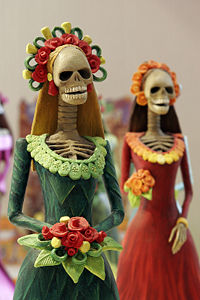
Home
Gualala Arts
Promoting public interest and participation in the arts since 1961.
Archive of past events: 2004 through 2014
¡VIVA LOS MUERTOS!
Gualala Arts will honor the dear departed - and the future departed (that's all of us) - in an afternoon of music and classic south-of-the-border treats. Admission is free. Join us for an afternoon of strolling mariachis in their finery, with local dancers bringing the spirit of Mexico to Gualala between 5:00 and 5:30 p.m. on our main stage. Enjoy traditional Mexican foods (deep, dark mole, tamales, tacos, Pan de Muerte or "Bread of the Dead," horchata rice beverage). Just to let the dead know what they're missing, we'll also taste fine tequilas and pour Mexico's famous beers, as well as local brews. ¡En Calavera!Gualala Arts Center's First
|
 Catrinas, one of the most popular figures of the Day of the Dead celebrations in Mexico. photo credit: Wikipedia |
The most instantly recognizable icon for the holiday is called "La Catrina," meaning the high society-lady, as depicted by Mexican master illustrator and engraver Jose Guadalupe Posada (1852-1913). The elegantly clad Catrina, grinning from beneath her huge, plumed hat, has further been immortalized by generations of later Mexican artists, including Mexican muralist Diego Rivera.
Posada's sharp socio-political commentary - that even wealth, prestige and privilege are no protection against La Muerte (Death) - is even sweetly present in the sugar skulls which are sold in many Mexican and Mexican-American communities today. Often, these skulls are as delicately decorated as wedding cakes, inscribed in flowery icing script with an individual's name. For those in a hurry, it's possible to purchase a calavera iced with a more generic holiday message: "Somos iguales." It means, simply, "We are equals."
Day of the Dead
Call for Shrines and Altars
Gualala Arts Center will host an exhibit of altars and shrines from October 27 to November 3, as part of the Día de los Muertos celebration. You can participate in this Day of the Dead festival by sharing your own personal shrine/altar with the community, or by creating a new work of art. The exhibits are not juried and are open to all, regardless of age or calling. Groups may want to collaborate in the creation of a special shrine/altar. The medium you choose can be as open as your imagination and may be as simple or as elaborate as you want. Since the purpose of a shrine/altar is remembrance, feel free to explore this theme in any way that speaks to you.
To participate in the exhibit, download the registration form. It is due by Saturday, October 25. There are a couple display options you might want to consider:
Create a shrine/altar to be installed and displayed outside, along the Gualala Arts Center Loop Trail. The artist is responsible for the installation (with consultation from the curators). The trail environment must not be disturbed in the installation or take-down of the shrine/altar.
Alternatively, you may submit a shrine/altar for display inside the Arts Center (in the Coleman Auditorium). This artwork may be either 2 or 3 dimensional, based on any theme related to Day of the Dead.
Día de los Muertos
(Day of the Dead)
Burnett Gallery
November 2008
Día de los Muertos (Day of the Dead)
November 2008
The Gualala Arts Center, located at 46501 Old State Highway in Gualala, CA,
is open weekdays 9:00 a.m. to 4:00 p.m., and weekends from noon to 4:00 p.m.
Please call (707) 884-1138 for more information, or email
info@gualalaarts.org.
Serving the coastal communities of northern Sonoma & southern Mendocino Counties.

 A sugar skull, delicately decorated with swirls of floral icing, and best of all, your name piped in ribbony script over the calavera's candy eyes - this is the sweetest, simplest metaphor for the traditional Mexican celebration, Día de los Muertos, known here in el norte as "Day of the Dead."
A sugar skull, delicately decorated with swirls of floral icing, and best of all, your name piped in ribbony script over the calavera's candy eyes - this is the sweetest, simplest metaphor for the traditional Mexican celebration, Día de los Muertos, known here in el norte as "Day of the Dead."